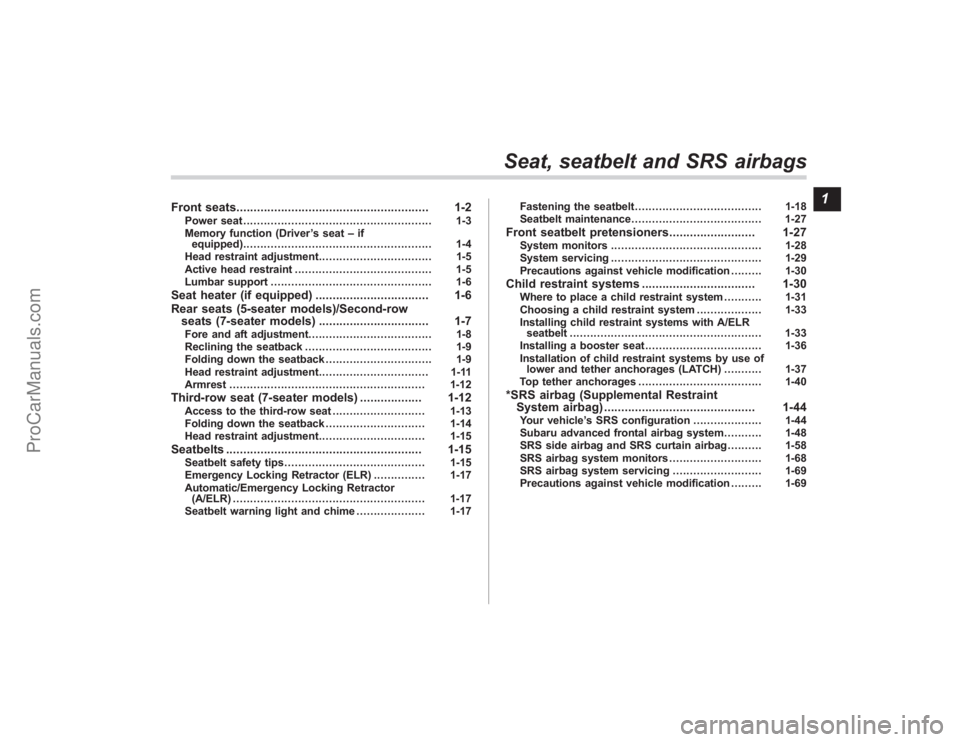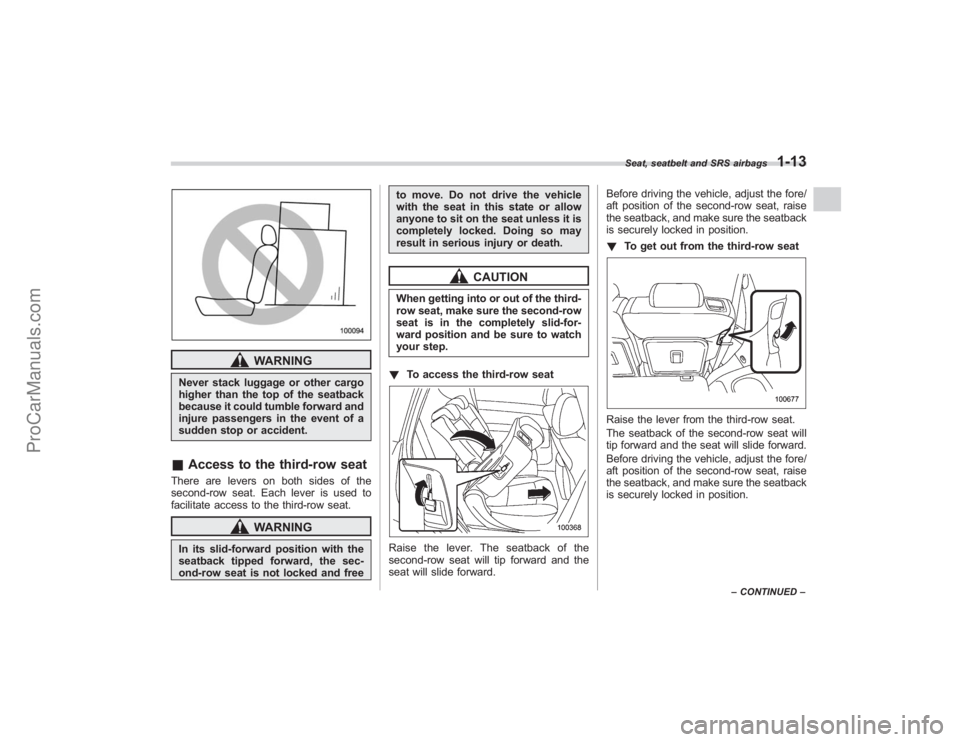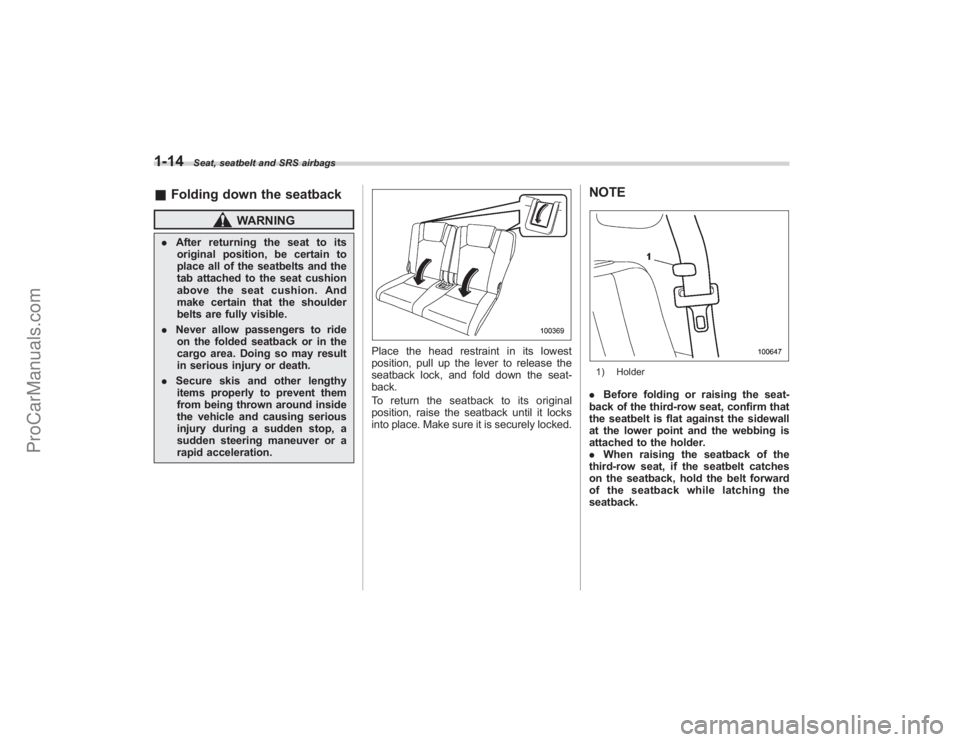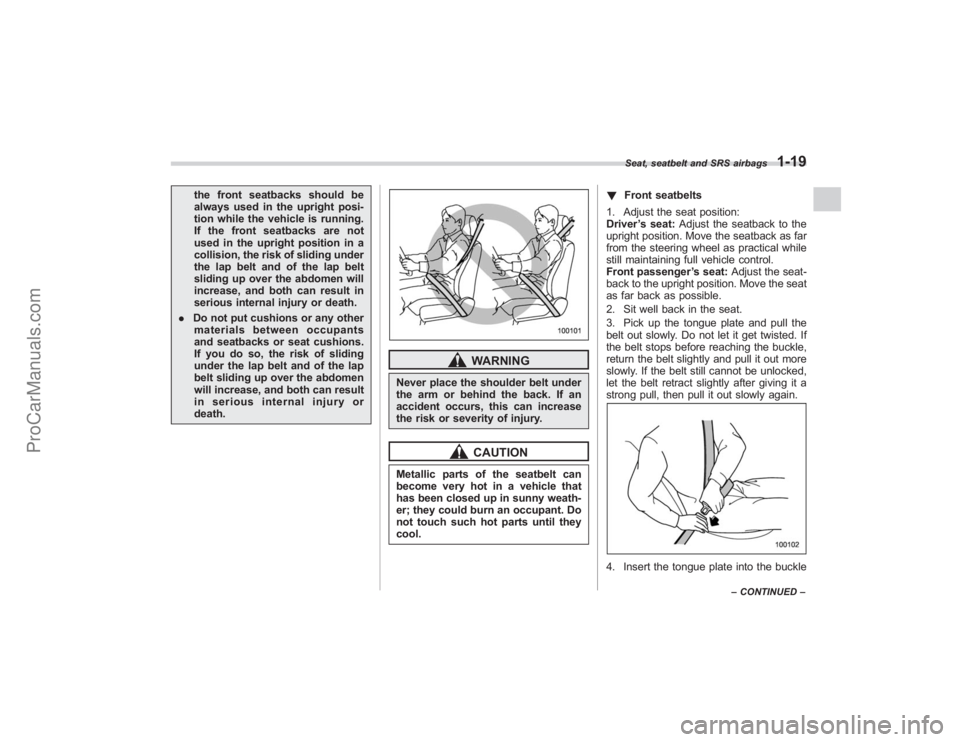2008 SUBARU TRIBECA lock
[x] Cancel search: lockPage 25 of 409

Front seats........................................................ 1-2
Power seat....................................................... 1-3
Memory function (Driver ’s seat –if
equipped) ....................................................... 1-4
Head restraint adjustment ................................. 1-5
Active head restraint ........................................ 1-5
Lumbar support ............................................... 1-6
Seat heater (if equipped) ................................. 1-6
Rear seats (5-seater models)/Second-row seats (7-seater models) ................................ 1-7
Fore and aft adjustment.................................... 1-8
Reclining the seatback ..................................... 1-9
Folding down the seatback ............................... 1-9
Head restraint adjustment ................................ 1-11
Armrest ......................................................... 1-12
Third-row seat (7-seater models) .................. 1-12
Access to the third-row seat........................... 1-13
Folding down the seatback ............................. 1-14
Head restraint adjustment ............................... 1-15
Seatbelts......................................................... 1-15
Seatbelt safety tips ......................................... 1-15
Emergency Locking Retractor (ELR) ............... 1-17
Automatic/Emergency Locking Retractor (A/ELR) ........................................................ 1-17
Seatbelt warning light and chime .................... 1-17Fastening the seatbelt
..................................... 1-18
Seatbelt maintenance...................................... 1-27
Front seatbelt pretensioners ......................... 1-27
System monitors............................................ 1-28
System servicing ............................................ 1-29
Precautions against vehicle modification ......... 1-30
Child restraint systems................................. 1-30
Where to place a child restraint system ........... 1-31
Choosing a child restraint system ................... 1-33
Installing child restraint systems with A/ELR seatbelt ........................................................ 1-33
Installing a booster seat .................................. 1-36
Installation of child restraint systems by use of lower and tether anchorages (LATCH) ........... 1-37
Top tether anchorages .................................... 1-40
*SRS airbag (Supplemental Restraint
System airbag) ............................................ 1-44
Your vehicle’s SRS configuration .................... 1-44
Subaru advanced frontal airbag system ........... 1-48
SRS side airbag and SRS curtain airbag .......... 1-58
SRS airbag system monitors ........................... 1-68
SRS airbag system servicing .......................... 1-69
Precautions against vehicle modification ......... 1-69
Seat, seatbelt and SRS airbags
1
ProCarManuals.com
Page 32 of 409

1-8
Seat, seatbelt and SRS airbags
injure passengers in the event of a
sudden stop or accident.&Fore and aft adjustment! 5-seater modelsPull the lever upward and slide the seat to
the desired position. Then release the
lever and move the seat back and forth to
make sure that it is securely locked into
place. !
7-seater models
Pull the lever upward and slide the seat to
the desired position.When the right seat or the left seat pair is
slid rearward, it stops partway at the lock
point so as not to trap the legs of passengers sitting on the third-row seat.
It is possible to slide the seat or seat pair
further rearward by releasing the lock that
stops it. To do this, simultaneously pull the
lever under the outboard seat cushion and
turn the lever on the side of the seat
cushion outward when sliding the seat or
seat pair.
Once you have released the lock, you can
slide the seat or seat pair back and forth
with only the lever under the seat cushion
pulled. If you slide the seat or seat pair
forward of the lock point, you will need to
release the lock again before you can
slide it behind the point.
Then release the lever and move the seat
back and forth to make sure that it is
securely locked into place.
CAUTION
If you slide the seat or seat pair aft
of the lock point while the third-row
seat is occupied, be careful not to
trap the legs of the third-row pas-
sengers.
ProCarManuals.com
Page 33 of 409

&Reclining the seatback
WARNING
To prevent the passenger from slid-
ing under the seatbelt in the event of
a collision, always put the seatback
in the upright position while the
vehicle is in motion. Also, do not
place objects such as cushions
between the passenger and the
seatback. If you do so, the risk of
sliding under the lap belt and of the
lap belt sliding up over the abdomen
will increase, and both can result in
serious internal injury or death.
CAUTION
. In a 7-seater model vehicle, never
allow the third-row seat passen-
gers to adjust the seatback of the
second row. Doing so is danger-
ous as the seatback will tilt
rapidly and could injure the pas-
sengers.
. If the cargo area cover is
equipped, be careful not to pinch
your hand between the headrest
and the cargo area cover when
you recline the rear seat.Pull the lever up and adjust the seatback
to the desired position.
Then release the lever and make sure the
seatback is securely locked into place.
& Folding down the seatback
WARNING
. After returning the seat to its
original position, be certain to
place all of the seatbelts and the
tab attached to the seat cushion
above the seat cushion. And
make certain that the shoulder
belts are fully visible.
. Never allow passengers to ride
on the folded seatback or in the
cargo area. Doing so may result
in serious injury or death.
. Secure skis and other lengthy
items properly to prevent them
from being thrown around inside
the vehicle and causing serious
injury during a sudden stop, a
sudden steering maneuver or a
rapid acceleration.
. If passengers are sitting on the
third-row seat, never drive while
folding the second-row seat. It
can be a serious interference at
the time of braking and impact.
. If passengers are sitting on the
third-row seat, never drive while
the center seatback of the sec-
ond-row seat is folded. Doing so
Seat, seatbelt and SRS airbags
1-9
– CONTINUED –
ProCarManuals.com
Page 34 of 409

1-10
Seat, seatbelt and SRS airbags
may result in serious injury in the
event of a hard braking or an
impact.
1. Slide the seat or seat pair to its
rearmost position.
2. Lower the head restraint to its lowest
position.
3. Unlock the seatback by pulling the
lever and then fold the seatback down.
4. To return the seatback to its original
position, raise the seatback until it locks
into place. Make sure it is securely locked.
By pulling the tab on the center seat, you
can fold only the seatback of the center
seat.
To return the seatback to its original
position, raise the seatback until it locks
into place. Make sure it is securely locked.
1) Bar
CAUTION
.Folding the seatback of the cen-
ter seat will expose the bar that
retains it in the raised position.
Be careful not to hurt yourself on
it. Especially, do not rest your
finger on the bar. Otherwise,
when the seatback is raised, your
finger could be pinched between
the bar and seatback and thus
injured.
ProCarManuals.com
Page 37 of 409

WARNING
Never stack luggage or other cargo
higher than the top of the seatback
because it could tumble forward and
injure passengers in the event of a
sudden stop or accident.&Access to the third-row seatThere are levers on both sides of the
second-row seat. Each lever is used to
facilitate access to the third-row seat.
WARNING
In its slid-forward position with the
seatback tipped forward, the sec-
ond-row seat is not locked and free to move. Do not drive the vehicle
with the seat in this state or allow
anyone to sit on the seat unless it is
completely locked. Doing so may
result in serious injury or death.
CAUTION
When getting into or out of the third-
row seat, make sure the second-row
seat is in the completely slid-for-
ward position and be sure to watch
your step.
! To access the third-row seatRaise the lever. The seatback of the
second-row seat will tip forward and the
seat will slide forward. Before driving the vehicle, adjust the fore/
aft position of the second-row seat, raise
the seatback, and make sure the seatback
is securely locked in position.
!
To get out from the third-row seat
Raise the lever from the third-row seat.
The seatback of the second-row seat will
tip forward and the seat will slide forward.
Before driving the vehicle, adjust the fore/
aft position of the second-row seat, raise
the seatback, and make sure the seatback
is securely locked in position.
Seat, seatbelt and SRS airbags
1-13
–CONTINUED –
ProCarManuals.com
Page 38 of 409

1-14
Seat, seatbelt and SRS airbags
&Folding down the seatback
WARNING
. After returning the seat to its
original position, be certain to
place all of the seatbelts and the
tab attached to the seat cushion
above the seat cushion. And
make certain that the shoulder
belts are fully visible.
. Never allow passengers to ride
on the folded seatback or in the
cargo area. Doing so may result
in serious injury or death.
. Secure skis and other lengthy
items properly to prevent them
from being thrown around inside
the vehicle and causing serious
injury during a sudden stop, a
sudden steering maneuver or a
rapid acceleration.
Place the head restraint in its lowest
position, pull up the lever to release the
seatback lock, and fold down the seat-
back.
To return the seatback to its original
position, raise the seatback until it locks
into place. Make sure it is securely locked.
NOTE1) Holder. Before folding or raising the seat-
back of the third-row seat, confirm that
the seatbelt is flat against the sidewall
at the lower point and the webbing is
attached to the holder.
. When raising the seatback of the
third-row seat, if the seatbelt catches
on the seatback, hold the belt forward
of the seatback while latching the
seatback.
ProCarManuals.com
Page 41 of 409

&Emergency Locking Retrac-
tor (ELR)The driver ’s seatbelt has an Emergency
Locking Retractor (ELR).
The emergency locking retractor allows
normal body movement but the retractor
locks automatically during a sudden stop,
impact or if you pull the belt very quickly
out of the retractor.& Automatic/Emergency Lock-
ing Retractor (A/ELR)Each passenger ’s seatbelt has an Auto-
matic/Emergency Locking Retractor (A/
ELR). The Automatic/Emergency Locking
Retractor normally functions as an Emer-
gency Locking Retractor (ELR). The A/
ELR has an additional locking mode
“ Automatic Locking Retractor (ALR)
mode ”intended to secure a child restraint
system. When the seatbelt is once drawn
out completely and is then retracted even
slightly, the retractor locks the seatbelt in
that position and the seatbelt cannot be
extended. As the belt is rewinding, clicks
will be heard which indicate the retractor
functions as ALR. When the seatbelt is
retracted fully, ALR mode is released.
When securing a child restraint system on
the passengers’ seats, the seatbelt must
be changed over to the Automatic Locking Retractor (ALR) mode.
When the child restraint system is re-
moved, make sure that the retractor is
restored to the Emergency Locking Re-
tractor (ELR) function by allowing the
seatbelt to retract fully.
For instructions on how to convert the
retractor to the ALR mode and restore it to
the ELR mode, refer to the
“Installing child
restraint systems with A/ELR seatbelt ”
section in this chapter.
&
Seatbelt warning light
and chime
Your vehicle is equipped with a seatbelt
warning device at the driver ’s and front
passenger ’s seat.
With the ignition switch turned to the “ON”
position, this device reminds the driver
and front passenger to fasten their seat-
belts by illuminating the warning lights in
the locations indicated in the following
illustrations and sounding a chime.
Driver ’s warning lightFront passenger ’s warning light! Operation
If the driver and/or front passenger have/
has not yet fastened the seatbelt(s) when
Seat, seatbelt and SRS airbags
1-17
– CONTINUED –
ProCarManuals.com
Page 43 of 409

the front seatbacks should be
always used in the upright posi-
tion while the vehicle is running.
If the front seatbacks are not
used in the upright position in a
collision, the risk of sliding under
the lap belt and of the lap belt
sliding up over the abdomen will
increase, and both can result in
serious internal injury or death.
. Do not put cushions or any other
materials between occupants
and seatbacks or seat cushions.
If you do so, the risk of sliding
under the lap belt and of the lap
belt sliding up over the abdomen
will increase, and both can result
in serious internal injury or
death.
WARNING
Never place the shoulder belt under
the arm or behind the back. If an
accident occurs, this can increase
the risk or severity of injury.
CAUTION
Metallic parts of the seatbelt can
become very hot in a vehicle that
has been closed up in sunny weath-
er; they could burn an occupant. Do
not touch such hot parts until they
cool. !
Front seatbelts
1. Adjust the seat position:
Driver ’s seat: Adjust the seatback to the
upright position. Move the seatback as far
from the steering wheel as practical while
still maintaining full vehicle control.
Front passenger ’s seat: Adjust the seat-
back to the upright position. Move the seat
as far back as possible.
2. Sit well back in the seat.
3. Pick up the tongue plate and pull the
belt out slowly. Do not let it get twisted. If
the belt stops before reaching the buckle,
return the belt slightly and pull it out more
slowly. If the belt still cannot be unlocked,
let the belt retract slightly after giving it a
strong pull, then pull it out slowly again.
4. Insert the tongue plate into the buckle
Seat, seatbelt and SRS airbags
1-19
– CONTINUED –
ProCarManuals.com